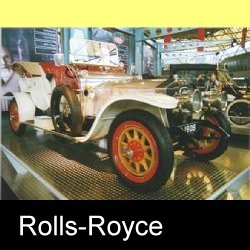|
Rolls-Royce behoeft als merk natuurlijk geen nadere introductie. De Honourable Charles Stuart Rolls
was een rijke aristocraat die verliefd werd op de automobiel. De beste auto's ter wereld aan het eind
van de vorige eeuw en het begin van deze eeuw kwamen uit Frankrijk (Rolls verkocht o.a. Panhard-
Levassor auto's in Londen) en het stak hem dat de Britse auto industrie op dat niveau geen rol van
betekenis speelde. Op een gegeven moment hoorde hij van een Brit die een Franse Décauville auto
gekocht had, maar daar absoluut niet tevreden over was. Die Brit, de zeer begaafde ingenieur
Frederick Henry Royce, besloot daarop zelf auto's te gaan bouwen. Die producten spraken Rolls
dermate aan, dat hij aanbood hun krachten te bundelen. Het moet voor Royce tamelijk moeilijk geweest
zijn omdat zijn wereld van arme en ingetogen technicus absoluut niet de wereld was van de rijke en
extraverte Rolls. Toch mocht het eindproduct er zijn. Na een aantal types verscheen in 1906-1907 hun
model dat de wereld versteld deed staan. De auto, de 40/50 PK was beter en anders dan wat er tot op
dat moment elders ter wereld gebouwd werd. De auto had een 6 cilinder motor van 7 liter en iedere
cilinder had twee bougies voor een betere ontsteking. Hij kreeg de bijnaam Silver Ghost omdat één van
de eerste exemplaren geheel in zilverkleurige lak was uitgevoerd en de radiateur en de lampen waren
zelfs echt verzilverd. Verder liep de motor zo rustig en stil dat je hem bijna niet aan hoorde komen. De
auto op de foto is de Silver Ghost uit 1909 van het National Motor Museum in Beaulieu, Engeland. Dit
model bleef in productie tot 1926. Lang kon Rolls niet van zijn auto's genieten, want in 1910 kwam hij
om het leven bij een vliegongeluk (zijn tweede passie). De herkenningsbakens van het merk, de Sprit of Ecstasy naar een ontwerp van de kunstenaar Charles Sykes en het embleem met de twee door elkaar geregen rode RR'en, behielden hun faam. Toen Royce als zeer oud man in 1933 overleed, werden de rode RR'en zwart, tot op de dag van vandaag...
|
Rolls-Royce, of course needs no further introduction. The Honourable Charles Stuart Rolls, a rich
aristocrat, fell in love with the automobile. The best cars in the world at that time, the end of the nineteenth century, beginning of 20th century were built in France (C.S. Rolls sold Panhard-Levassor cars
in London) and he was not at all amused by the thought that British engineers were not able to equal
the level of craftsmanship displayed by the leading French manufacturers. At one moment, Rolls heard
of an Englishman who bought a Décauville car, that did not quite meet his demands, to put it mildly. This
man, the very talented engineer Frederick Henry Royce, decided to build cars of his own. C.S. Rolls
met F.H. Royce and was impressed by the quality of his cars. He proposed a partnership. It must have
been rather difficult for the simple, down-to-earth Royce to form a partnership with this wealthy and
extravagant aristocrat. Today, we know we must be very grateful to him to accept Rolls' proposition,
and, the end result was quite something. After introducing some other types, their name was set world
wide with the birth of the 40/50 HP in 1906-1907. It was better than anything else the world had produced until that moment. The car had a six cilinder engine of 7 litres capacity and each cilinder had 2
spark plugs for better ignition. It was called the Silver Ghost because one of the first cars of this type
was painted entirely in silver and the radiator cowl and lights were silver plated. The car ran so smoothly
and quietly that you could hardly hear it coming. The car in the picture is the 1909 Silver Ghost from
The National Motor Museum in Beaulieu. The Silver Ghost was produced until 1926. C.S. Rolls,
however, could not enjoy his partnership for very long, for in 1910 he was killed in a flying accident
(his second passion). The most famous parts of R-R, the Spirit of Ecstasy, designed by the artist
Charles Sykes, and the emblem with the two red RR's, continued to conquer the world. By 1933, when
F.H. Royce died an old man, the two red letters RR became black, until today...
|


